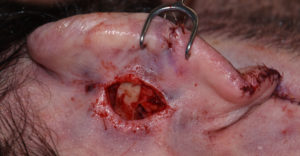Otoplasty is the most common total ear reshaping surgery. Its objective is to take an ear that sticks out too far and bring it in closer to the side of the head. This is typically done by changing the shape of the cartilage through sutures placed on the back of the ear. How much the ear should be set back is a matter of judgment and there is a fine line between too far and not enough.
When the ear appears set back too far it it important to realize that some relaxation of the initial ear position may relax and be just fine. One should give it a month or two to see how it heals and looks. If the ear still looks too far back at that point a surgical revision can be done to loosen or replace the cartilage plication sutures for better ear positioning.
But months or years after an otoplasty, the opportunity for simple suture release has passed. Releasing the sutures or the scar behind the ear will not work. The ear cartilage cartilage has lost its memory and has stiffened into its reshaped position. Even removing scar tissue and scoring the cartilage in an attempt to release it even a few millimeters does not usually work either.
The key to a successful otoplasty reversal is the use of an interpositional graft. Once the cartilage has been released it needs to be held out into its new position. The ideal interpositional graft would be a piece of rib cartilage. While a cartilage graft from the patient would be the ideal material to use the idea of a donor site is not usually that appealing for an elective aesthetic procedure.

I have used a lot of different materials in otoplasty reversal procedures. These have included metal clips, autologous cartilage, and tissue bank bone and cartilage. While all of these interpositional materials have worked, cadaveric cartilage grafting seems the most biologic and avoids the need for a donor site.
Dr. Barry Eppley
Indianapolis, Indiana


